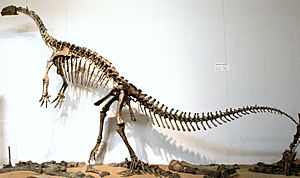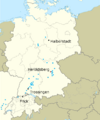Plateosaurus facts for kids
Quick facts for kids Plateosaurus |
|
|---|---|
 |
|
| Mounted skeleton of Plateosaurus, Eberhard-Karls-University Tübingen, Germany | |
| Scientific classification | |
| Kingdom: | |
| Class: | |
| Superorder: | |
| Order: | |
| Suborder: | |
| Infraorder: | |
| Family: | |
| Genus: |
Plateosaurus
Meyer, 1837
|
Plateosaurus (say "PLAY-tee-oh-SAWR-us") means 'flat lizard'. It was a type of long-necked dinosaur called a prosauropod. These amazing plant-eaters lived a very long time ago, about 216 to 199 million years ago. This was during the Upper Triassic period. You could find them in what is now Europe.
The Plateosaurus was one of the first big plant-eating dinosaurs with a long neck. An adult Plateosaurus could be as long as 27 feet (about 8 meters). That's like two cars parked bumper to bumper! They could also weigh up to 1,500 pounds (about 680 kilograms). That's heavier than a small car!
Contents
What Plateosaurus Looked Like
Plateosaurus had a long neck and a long tail. Their bodies were quite strong. They had strong hind legs and shorter front limbs. Scientists believe they could walk on two legs (bipedal) or sometimes on all four legs (quadrupedal).
Their hands were interesting! They had five fingers, and a very special, large, sharp claw on their thumb. This big thumb claw was probably used for defense. It could also help them pull down branches to reach tasty leaves.
What Plateosaurus Ate
Plateosaurus was a herbivore, meaning it ate only plants. They were the first large plant-eaters of their time. They used their hands to grab leaves from trees. Even though they had weak teeth, they could still chew their food. They probably swallowed stones, called gastroliths, to help grind up tough plant material in their stomachs, just like some birds do today.
Where Plateosaurus Lived
Fossils of Plateosaurus have been found mostly in Europe. Many important fossil sites are in countries like Germany and Switzerland. These areas were once part of a large continent called Pangaea. The climate back then was likely warm and dry, with forests and open plains.
How We Know About Plateosaurus
Scientists have found many Plateosaurus skeletons. Some of these skeletons are very complete! This helps us learn a lot about how they lived and moved. For example, the way their bones fit together tells us they were agile and could stand on two legs.
One famous discovery was in Trossingen, Germany. Many Plateosaurus skeletons were found there. Some were even found in the position they died in, with their hind limbs folded. This suggests they might have been buried quickly, perhaps by floods.
Images for kids
-
P. engelhardti, collection number F 33 of the Staatliches Museum für Naturkunde Stuttgart, Germany, in dorsal view. The skeleton was kept in articulation as found at Trossingen by Seemann in 1933. It has the typical folded hind limbs of most Plateosaurus finds. Unusually, the anterior body is not twisted to one side.
-
P. engelhardti skull cast, Royal Ontario Museum
-
Mounted cast of SMNS 13200. An example of the out-dated skeleton mounts in the State Museum of Natural History Stuttgart in quadrupedal posture. The shoulder girdle is in an anatomically infeasible position, the elbow is disarticulated, and the ribcage has the wrong shape, wide instead of high oval.
-
Mount of P. engelhardti GPIT/RE/7288, a nearly complete individual from Trossingen at the museum of the Institute for Geosciences of the Eberhard-Karls-University Tübingen, Germany. Anatomically, this mount created under the direction of Friedrich von Huene is one of the best in the world, epitomising the agile, bipedal and digitigrade view of Plateosaurus confirmed by recent research.
See also
 In Spanish: Plateosaurus para niños
In Spanish: Plateosaurus para niños












